Related Research Articles
The 1923 Victorian police strike occurred in Melbourne, Victoria, Australia. In November 1923, on the eve of the Melbourne Spring Racing Carnival, half the police force in Melbourne went on strike over the operation of a supervisory system using labour spies, nicknamed "spooks". Riots and looting followed as crowds poured out of the main Flinders Street railway station on the Friday and Saturday nights and made their way up Elizabeth and Swanston streets, smashing shop windows, looting, and overturning a tram.

The 1912 Brisbane General Strike in Queensland, Australia, began when members of the Australian Tramway and Motor Omnibus Employees' Association were dismissed when they wore union badges to work on 18 January 1912. They then marched to Brisbane Trades Hall where a meeting was held, with a mass protest meeting of 10,000 people held that night in Market Square.

The Battle of George Square was a violent confrontation in Glasgow, Scotland between City of Glasgow Police and striking workers, centred around George Square. The "battle", also known as "Bloody Friday" or "Black Friday", took place on Friday 31 January 1919, shortly after the end of the First World War. During the riot, the Sheriff of Lanarkshire called for military aid, and government troops, supported by six tanks, were moved to key points in the city. The strike leaders were arrested for inciting the riot. Although it is often stated that there were no fatalities, one police constable died several months later from injuries received during the rioting.

The Miners Strike of 1910-11 was an attempt by miners and their families to improve wages and living conditions in severely deprived parts of South Wales, where wages had been kept deliberately low for many years by a cartel of mine owners.

Sussex Police is the territorial police force responsible for policing in the whole of Sussex. Its jurisdiction covers the ceremonial counties of East Sussex and West Sussex. The force is headquartered in Malling House, Lewes, East Sussex.
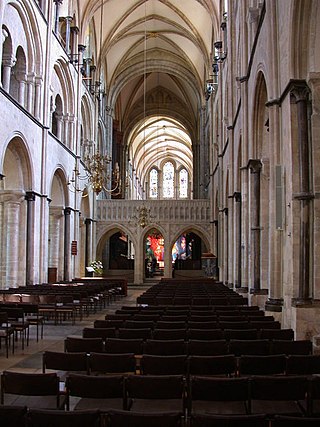
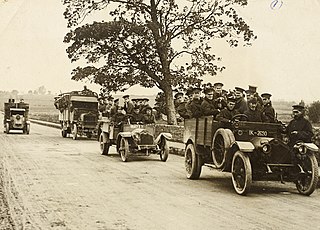
This is a timeline of the Irish War of Independence of 1919–21. The Irish War of Independence was a guerrilla conflict and most of the fighting was conducted on a small scale by the standards of conventional warfare.
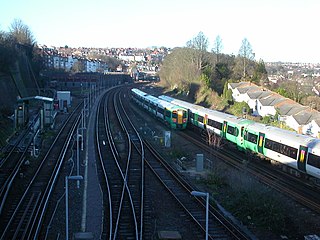
Public transport in Brighton and Hove, a city on the south coast of England, dates back to 1840. Brighton and Hove has a major railway station, an extensive bus service, many taxis, coach services, and it has previously had trolley buses, ferries, trams, auto rickshaws and hydrofoils.
The Battle of Ballantyne Pier occurred in Ballantyne Pier during a docker's strike in Vancouver, British Columbia, in June 1935.

The Memphis sanitation strike began on February 12, 1968, in response to the deaths of sanitation workers Echol Cole and Robert Walker. The deaths served as a breaking point for more than 1,300 African American men from the Memphis Department of Public Works as they demanded higher wages, time and a half overtime, dues check-off, safety measures, and pay for the rainy days when they were told to go home.

Round Hill is an inner suburban area of Brighton, part of the coastal city of Brighton and Hove in England. The area contains a mix of privately owned and privately rented terraced housing, much of which has been converted for multiple occupancies, and small-scale commercial development. It was developed mostly in the late 19th century on an area of high land overlooking central Brighton and with good views in all directions, the area became a desirable middle-class suburb—particularly the large terraced houses of Roundhill Crescent and Richmond Road, and the exclusive Park Crescent—and within a few decades the whole of the hill had been built up with smaller terraces and some large villas.
Industrial violence refers to acts of violence which occur within the context of industrial relations. These disputes can involve employers and employees, unions, employer organisations and the state. There is not a singular theory which can explain the conditions under which industrial conflicts become violent. However, there are a variety of partial explanations provided by theoretical frameworks on collective violence, social conflict and labor protest and militancy.

Brighton Corporation Tramways operated an electric tramway service in Brighton between 1901 and 1939.

Elm Grove is a mainly residential area of Brighton, part of the English coastal city of Brighton and Hove. The densely populated district lies on a steep hill northeast of the city centre and developed in the second half of the 19th century after the laying out of a major west–east road, also called Elm Grove. Terraced houses, small shops and architecturally impressive public buildings characterise the streetscape: within the area are a major hospital, two churches and a former board school, as well as Brighton's oldest council houses and an interwar council estate.
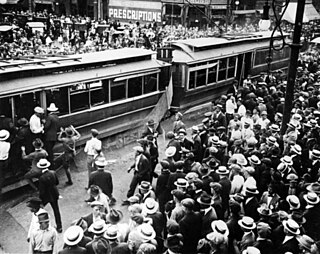
The Denver streetcar strike of 1920 was a labor action and series of urban riots in downtown Denver, Colorado, beginning on August 1, 1920, and lasting six days. Seven were killed and 50 were seriously injured in clashes among striking streetcar workers, strike-breakers, local police, federal troops and the public. This was the "largest and most violent labor dispute involving transportation workers and federal troops".
The Brighton Herald was a weekly newspaper covering the boroughs of Brighton and Hove in southeast England. Founded in 1806 as the first newspaper in the fashionable seaside resort of Brighton, it survived until 1971 and was one of England's "leading provincial weekly" newspapers—being the first publication in the country to report several important international events, such as Napoleon's escape and the start of the July Revolution. Based in the centre of Brighton throughout its 165-year existence, it moved in 1934 to new premises at Pavilion Buildings, near the Royal Pavilion.
The Cinderloo Uprising took place at Old Park in the Coalbrookdale Coalfield on 2 February 1821, when the South Shropshire Yeomanry confronted a crowd of 3,000 mostly striking workers who had gathered to protest the continued lowering of their pay.
The 1932 Christchurch tramway strike was an industrial dispute between tramway workers and their employers that took place in the city of Christchurch, New Zealand during the Great Depression. It lasted 16 days and led to the injury and arrest of many local people on both sides of the dispute.

Brighton and Hove, a city and unitary authority in the English county of East Sussex, has a wide range of public services funded by national government, East Sussex County Council, Brighton and Hove City Council and other public-sector bodies. Revenue to fund these services comes partly from Council Tax, which is paid annually by residents: this tax provides the city council with nearly 20% of its income and also helps to fund the local police force, Sussex Police, and the county's fire service, East Sussex Fire and Rescue Service. Some of Brighton and Hove's utilities and infrastructure are provided by outside parties, such as utility companies, rather than by the city council.
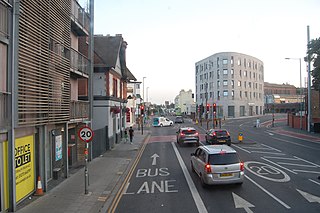
Lewes Road is a major road in the English seaside city of Brighton and Hove. It was part of the A27 cross-country trunk route until the Brighton Bypass took this designation in the 1990s; since then it has been designated the A270. The road runs northeastwards from central Brighton through a steep-sided valley, joining the A27 at the city boundary and continuing to Lewes, the county town of East Sussex.
References
- 1 2 3 4 5 6 7 Lowerson, John (1980). A Short History of Sussex. Folkestone: Wm Dawson & Son Ltd. pp. 179–180. ISBN 0712909486.
- 1 2 3 4 5 6 7 8 Carder, Timothy (1990). "Tramways". The Encyclopedia of Brighton. Lewes: East Sussex County Libraries. Entry 185. ISBN 0861473159.
- ↑ Walton, John K. (18 November 2000). The British Seaside: Holidays and Resorts in the Twentieth Century. Manchester: Manchester University Press. pp. 191–192. ISBN 0719051703 . Retrieved 20 April 2012.
- 1 2 Burchill, Julie; Raven, Daniel (15 April 2008). Made in Brighton: From the Grand to the Gutter: Modern Britain as Seen from Beside the Sea. New York: Random House. p. 170. ISBN 978-0753513521 . Retrieved 20 April 2012.
- 1 2 Brighton and Hove Herald May 15th 1926
- ↑ Durr, Andy (1976). Who Were the Guilty?. Brighton: Brighton Labour History Press. p. 26. ISBN 9780950511702.
- ↑ Fielding, Nigel (20 December 2005). The Police and Social Conflict. London: Routledge. p. 42. ISBN 1904385230 . Retrieved 20 April 2012.